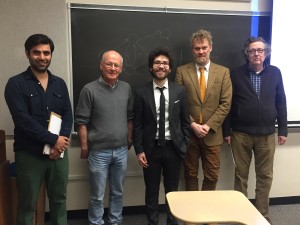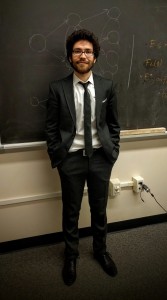Burak Kaya successfully defended his dissertation, “Cantor minimal systems from a descriptive perspective,” on March 24, 2016, earning his Ph.D. degree at Rutgers University under the supervision of Simon Thomas. The dissertation committee consisted of Simon Thomas, Gregory Cherlin, Grigor Sargsyan and myself, as the outside member.
The defense was very nice, with an extremely clear account of the main results, and the question session included a philosophical discussion on various matters connected with the dissertation, including the principle attributed to Gao that any collection of mathematical structures that has a natural Borel representation has a unique such representation up to Borel isomorphism, a principle that was presented as a Borel-equivalence-relation-theory analogue of the Church-Turing thesis.
Burak Kaya | MathOverflow profile | ar$\chi$iv profile
Abstract. In recent years, the study of the Borel complexity of naturally occurring classification problems has been a major focus in descriptive set theory. This thesis is a contribution to the project of analyzing the Borel complexity of the topological conjugacy relation on various Cantor minimal systems.
We prove that the topological conjugacy relation on pointed Cantor minimal systems is Borel bireducible with the Borel equivalence relation $\newcommand\d{\Delta^+_{\mathbb{R}}}\d$. As a byproduct of our analysis, we also show that $\d$ is a lower bound for the topological conjugacy relation on Cantor minimal systems.
The other main result of this thesis concerns the topological conjugacy relation on Toeplitz subshifts. We prove that the topological conjugacy relation on Toeplitz subshifts with separated holes is a hyperfinite Borel equivalence relation. This result provides a partial affirmative answer to a question asked by Sabok and Tsankov.
As pointed Cantor minimal systems are represented by properly ordered Bratteli diagrams, we also establish that the Borel complexity of equivalence of properly ordered Bratteli diagrams is $\d$.



Tebrikler (Turkish: congratulations) to Burak! 🙂
By the way, Burak shared your beautiful group photo in his Facebook page! Why not adding that here?
The topic of this dissertation is really interesting. I’m also quite eager to know more about the philosophical discussion in the question session! Is there any reference (book, paper, lecture, …) in which the same topic is discussed? What is the philosophical issue about Borel-equivalence-relation-theory analogue of the Church-Turing thesis?
Thank you, Ali. I sent the photo to Prof. Hamkins in case he wants to share it.
The philosophical discussion Prof. Hamkins refers to is mentioned in Su Gao’s book “Invariant Descriptive Set Theory” on page 328. (For example, you can check the following link: https://books.google.com/books?id=VfiOZWY282QC&q=328&f=false#v=snippet&q=328&f=false)
It turns out that in practice, whenever we code the same class of structures as different standard Borel spaces, these codings turn out to be equivalent.
Some time ago, I e-mailed Prof. Gao to learn where this principle first appeared. He told me that as far as he knows, it is the first time (or maybe the only time) this principle appeared in the literature. So, I won’t be able to provide many sources besides this.
Simon Thomas also remarked during the defense that Matt Foreman gave a public lecture about this phenomenon at some point.
Thanks for the photo, which I have now posted.
Also, I have asked a question on MathOverflow concerning the philosophical question we were discussing. See http://mathoverflow.net/q/234585/1946.
Thank you for the references Burak! Also thanks to Joel for the complete and very interesting explanations about the philosophical issue in his MathOverflow question.